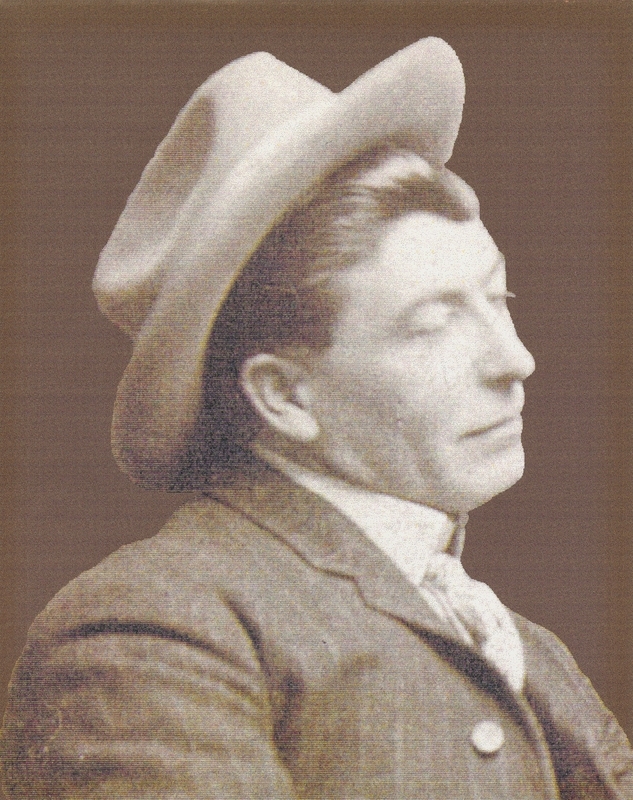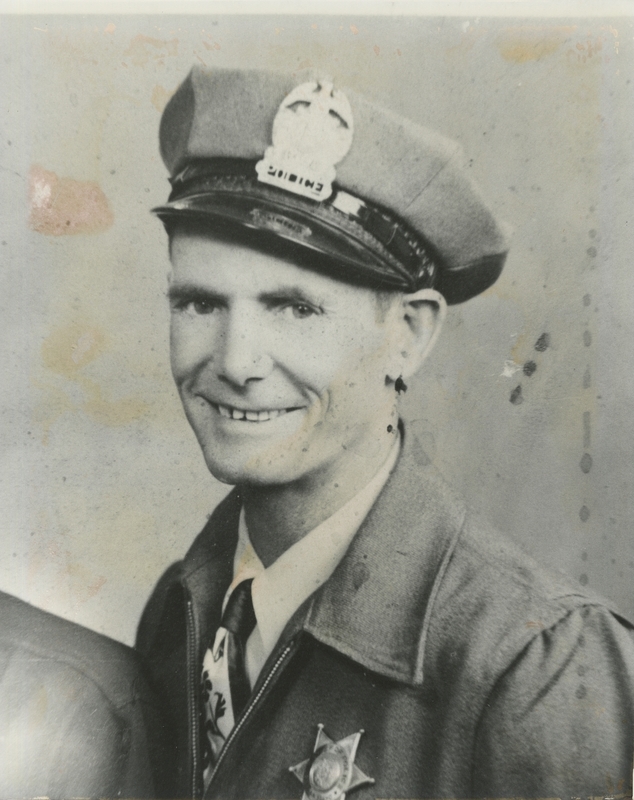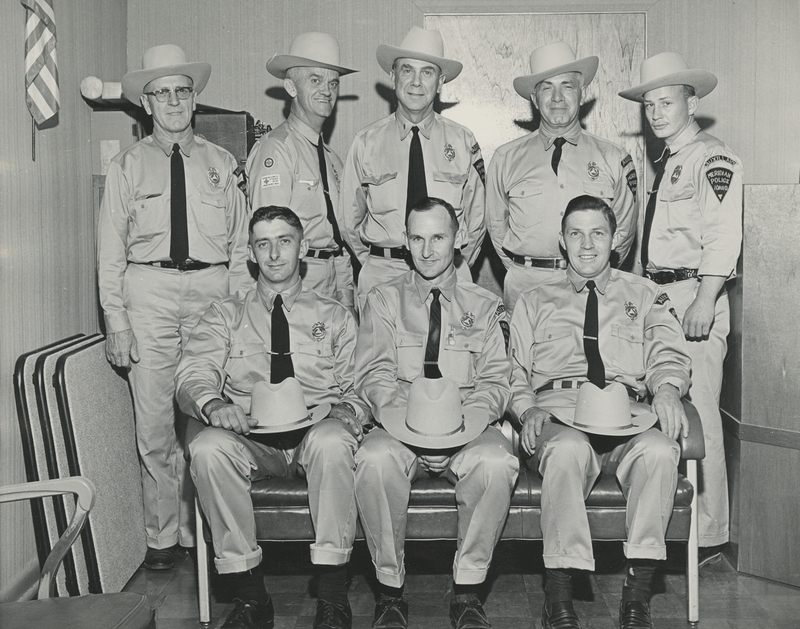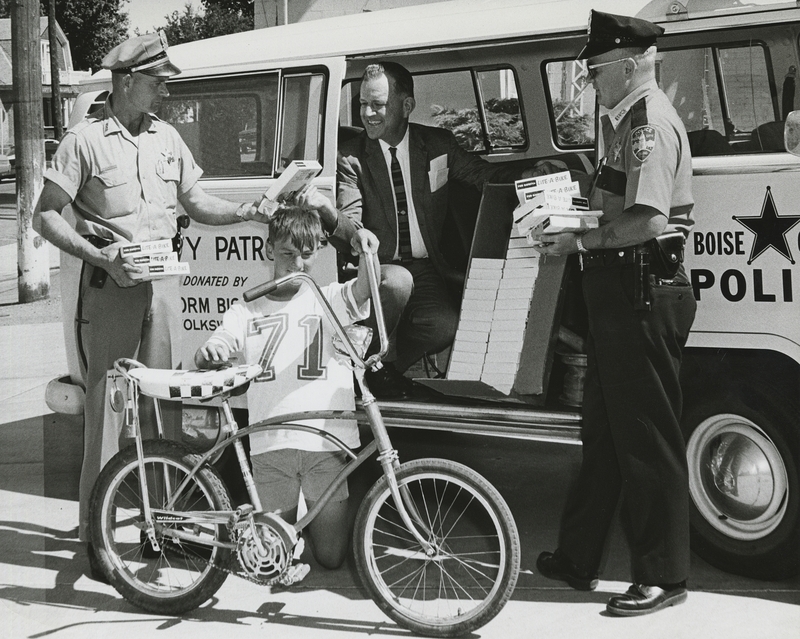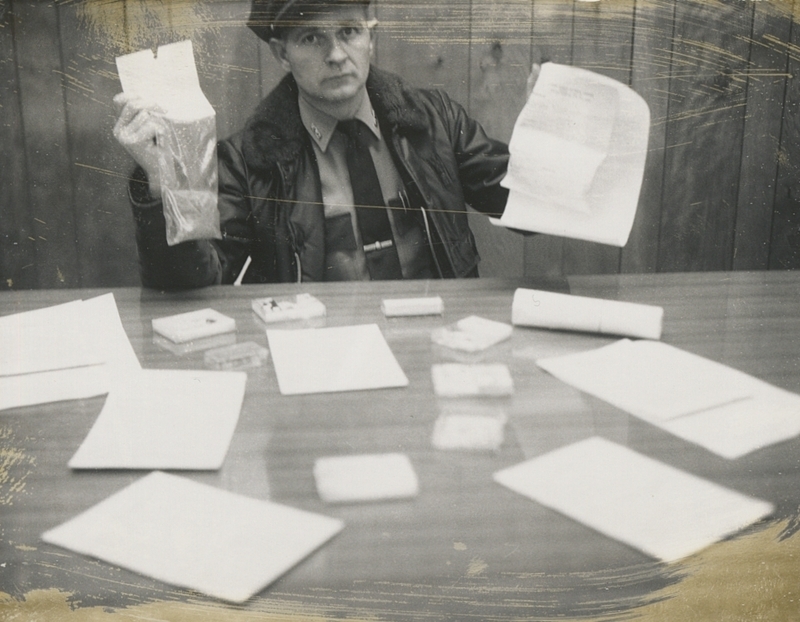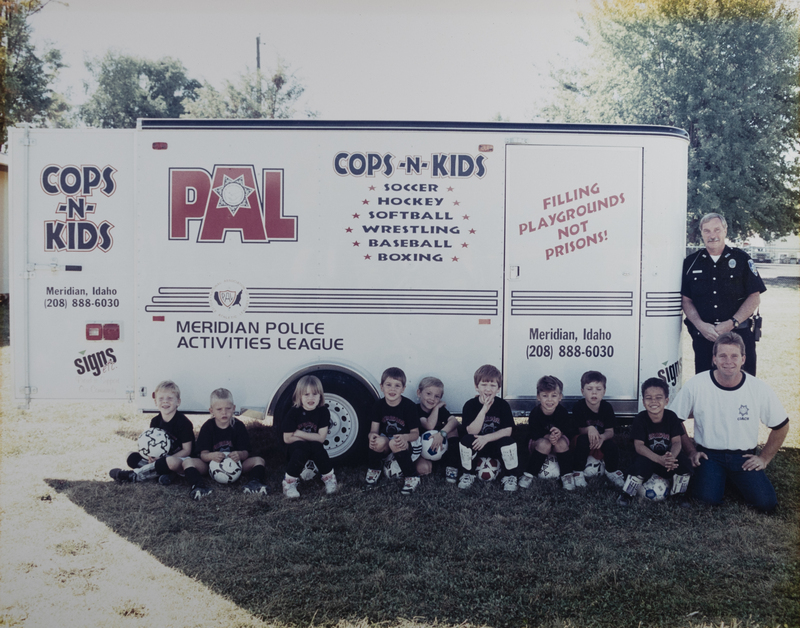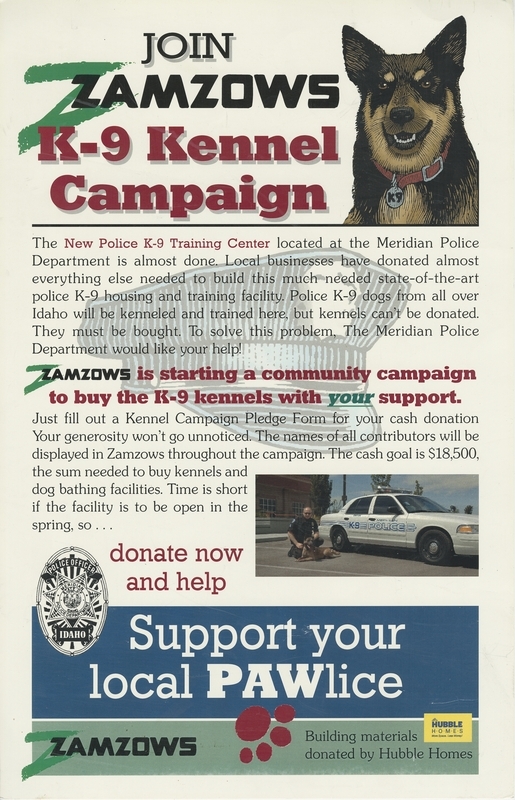Meridian Police
Exploring the History of the Meridian, Idaho Police Department
Contents: Introduction to the History of Law Enforcement in Meridian, Idaho | Law Enforcement in Early Meridian | Law Enforcement in Meridian Post World War II:Growth and More Police | Police Take on Drugs in Meridian | Community Policing & The K-9 Unit | History Conclusion | Meridian Marshal & Police Chief Chronology | Sources for History of Law Enforcement in Meridian, Idaho | About the Meridian Police Collection | Tech
Introduction to the History of Law Enforcement in Meridian, Idaho:
When Meridian was established in 1903, the Village Board of Trustees, among their other duties, were in charge of selecting and providing a village marshal to enforce the laws and ordinances of the city. On September 1, 1903 the first village marshal, Otis Pfost, was voted in by the Village Board with a wage of $25 per month (Village Minutes, September 1, 1903; January 4, 1904). Since then, the city of Meridian has had numerous marshals (later known as police chiefs) and, as needed with population growth, the addition of numerous police officers. The following is only a snapshot of the history of law enforcement in Meridian, Idaho.
Law Enforcement in Early Meridian:
Marshals in the early days of Meridian served in a variety of capacities. They were tasked with getting booths and preparing a room for voting on election day, as well as making sure the ballots were printed according to the specifications the city requested (Village Minutes April 2, 1904; April 3, 1905). Marshals were also in charge of managing local roads, from fixing and maintaining road conditions such as crossings and sidewalks, to hiring workers for larger projects. For instance, if the village board had notified property owners to place sidewalks in front of their property and residents had not yet complied, the Village Board authorized the marshal to complete the task and charge the property owners on behalf of the village (Village Minutes May 7, 1905). Marshals were responsible for transferring arrested individuals to the Boise jail if needed, verifying if saloon keepers were obeying Sunday closing laws, and reporting them to the village board for license revoking if in violation. Duties also included managing, controlling, and placing stray dogs in a room for keeping, and occasionally investigating saloon gambling (Village Minutes November 2, 1903; April 3, 1905; June 5, 1905). These are just a small portion of Marshal responsibilities that kept Meridian safe.
Occasionally, Meridian approved of deputies to help marshals when they were needed. The amount of law enforcement personnel was largely dependent on the needs of the community and the population of the town. For instance in 1915, John Finch and Ben Lusby started serving together as Marshal and Deputy Marshal respectively. Often, some marshals were approved by the Village Board of Trustees and then resigned only after a few months or less of service. The frequency of this turnover, as well as the occasional assignment of night and deputy marshals presents a dilemma for piecing together all of the individuals that might have served in a marshal capacity in early Meridian. With this in mind, included on this page is a rough chronology of all the marshals and police chiefs that have served in Meridian from 1903 to the present.
Law Enforcement in Meridian Post World War II: Growth & More Police
If residents were in need of assistance in Meridian they could knock on the door of the home of the police chief as well as telephoning them at their homes. For example, on March 15, 1949, 14 year old Jack Fulfer, while walking home from the theater, noticed three men breaking into a Meridian lumber company. Fulfer quickly turned around and ran several blocks away to Police Chief Bill McGill’s home. Chief McGill was able to take action, and pursued a manhunt for the individuals as they ran off and hid nearby. Two of the three men, Gordon L. Calkins and Robert Carson, were apprehended and the third man got away. (“The Capture,” 40).
In the early 1950s, Meridian’s police force was small. In fact, when Steve McGill took over as police chief in August of 1953, he was the whole police force. Steve McGill held down the job on his own, on call for 24 hours a day for three years, before another officer was hired. Despite the small police force, Police Chief Steve McGill believed Meridian to have effective law enforcement. In his first four years as chief Meridian had no fatal traffic accidents, no murders, no armed robberies, and only six burglaries (“Men About Meridian,” 1). In large part, McGill credited this to the surrounding community. McGill told the Gem State Peace Officer magazine, “By working in cooperation with the Nampa and Boise city police departments, as well as Ada County Sheriff’s office and Idaho State Police, we are able to carry out an effective system of law enforcement for Meridian.” Much of this efficiency came from the Meridian police having access to two-way radio to communicate with other police and sheriff’s forces throughout the Boise valley (“Meridian Police Department Keynotes Cooperation,” 57). The hiring of another additional policeman in the late 1950s also helped.
In the post World War II era of policing in Meridian, officers found themselves regularly interacting with two modes of transportation, cars and bicycles. After the war, many racing enthusiasts created quarter mile dirt tracks for racing, and in this culture the popular Meridian Speedway was created. As “jalopy racing” became more popular, traffic at the speedway in Meridian increased. By the mid 1950s, each Saturday in the summer, 500 to 1,000 cars converged on the venue with up to 3,000 people being able to be seated for the races. The Meridian police, with the aid of the Ada County Sheriffs, and other volunteers helped in managing the traffic both before and after the events. (Meridian Builds for Community Needs, Gem State Peace Officers, 1959 Vol 13 No. 1, 1959, 51). As the population continued to increase in Meridian, so did regular daily traffic. By the early 1960s, three new large subdivisions had been built, and Police Chief Oren E. Pritchard perceived traffic as the major issue facing the community. In order to take action, Chief Pritchard installed an Auxiliary Police Unit. This unit of volunteer police was designated to help the present police force (the Chief and two police officers) on occasion and assist on city road blocks. The auxiliary police were trained on first aid, handling traffic (especially the Speedway), and conducting a search. Eventually, the auxiliary police were provided with suntan uniforms, light blue hats, and silver badges containing Civil Defense emblems (“Pritchard, New Meridian Chief,” 15; Roam, 57).
Meridian’s growth meant not only were cars increasing, but so were bicycles. By the 1960s it was estimated that the United States had 30 million bicycles in public use. Bicycles were not just a way to get from one place to another, but a method of staying healthy. Notable health officials, professional sports coaches, and even former U.S. Presidents lauded the health benefits of bicycling (Safe Bicycling, Idaho Peace Officer, Sept 1966, pg 21). In the 1960s, Meridian’s city officials and police were wrestling with the topic of bicycle safety. Meridian Police Chief Gene Hiner focused on reminding residents that bicyclists needed to follow the same traffic rules as vehicles, and the Meridian city council passed new ordinances to maintain bicycle safety (“Police Warn Bike Riders,” 8; “City Officials pass new law on bicycles,” 1). Chief Hiner and the Meridian police sponsored community bike trainings for grade schools, and in 1968 participated in a statewide effort by local police authorities to promote luminous safety tape for bicycles by handing out the tape to the public (“Bicycle safety plan can save lives,” 10).
Police Take on Drugs in Meridian:
In the late 1960s and early 1970s, Meridian officials and police became concerned about growing drug issues. Marijuana and narcotics were beginning to be seized throughout Ada County, and many of the culprits were youth. On March 3, 1970, a public meeting was held at Meridian High School for parents, teenagers, and all who wished to attend. The meeting featured a public panel with a Boise College student, a Boise police officer, Meridian High School principal Gus Hines, Meridian High School’s current student body president, Mayor Don Storey, and Meridian Police Chief Gene Hiner. Chief Hiner opened the meeting describing teenage drug use in Meridian, specifically focusing on how even experimentation led to addiction and the need to steal and find means to purchase drugs. Scott Canning, the student body president, explained that the major reasons for drug use were experimentation and wanting to fit in. Mayor Storey highlighted his concerns, and told the public that Meridian was prepared to hire two more police officers, bringing the police force to four full time men and one part time patrolman. The meeting was viewed as a success and provides a view into Meridian’s combating of drug use, a concern among communities and schools across the country (“Meridian Holds Drug Discussion,” 53).
Community Policing & The K-9 Unit:
By the mid 1990s the Meridian Police Department had 23 police officers. In May of 1995, Police Chief Bill Gordon, in an effort to get ahead of population growth and the potential for crime resulting from growth, implemented a Community Policing Philosophy in the department. Officer Terry Tipton transferred into a new position for Community Policing and was assigned to create programs to interact with the community, train officers in the new philosophy, and build working relationships between the community and police officers. One of the initiatives developed from community policing was the Police Activities League (P.A.L.). P.A.L. was a program to ensure kids got involved in more productive and wholesome activities. Meridian viewed this as important because in 1994, 82% of Meridian’s crimes were committed by juvenile offenders. If the police were able to interact with the kids in this capacity, they believed they could instill a respect for the law and social responsibility. The P.A.L. focused on activities such as soccer, cooking classes, slot car racing, and bowling. Community policing also created Citizens on Patrol, where volunteers could be trained in a Citizen Academy, in which they would learn skills to observe, patrol, and contact crime directly to officers on duty (Tipton, 7).
In 1998, Meridian Police began discussing the possibility of a K-9 training facility located in the city. Then Meridian patrol Lt. Jeff Lavey and a K-9 officer from Nampa came up with the idea when attending an out of state training. Meridian police officer Gary Schelhing went to work coordinating volunteers and donations for the project. The community came together in a strong show of support in the following years, including a large cash donation from Hubble Homes and local business Zamzows helping to raise funds for all the kennels needed. On June 7, 2006 the K-9 facility opened with a 3,883 square foot building and 2 acres of outdoor space. The training facility included two training rooms, a dog wash area, and room to add additional kennels. Not only were police dogs to be trained here, but regional training for law enforcement would be held here. (Kreller, 11-12).
History Conclusion:
The above history is only meant to be a brief snapshot of the history of law enforcement in Meridian, Idaho. What started as a small village with one marshal, has grown into a booming city with 143 sworn officers and 43 professional staffers. Meridian Law enforcement has participated in numerous activities in its over one hundred year history. Of course, the majority of these activities involved stories of enforcing the law and arresting law breakers when the situations arose. However, Meridian police officers do far more. They live in the community, they participate with the community, and they serve the community. Most of their history goes unrecognized, but this digital collection seeks to shine a little light on the history of the Meridian Police Department.
Meridian Marshal & Police Chief Chronology
1903: Marshal Otis Pfost (September 1903-February 1904)
1904: Marshal P.F. Doherty (March 1904-April 1904)
1904: Marshal John Wilburn (April 1904-December 1904)
1905: Marshal Bert Daly (December 1904-August 1905)
1905: Marshal Mack Starr (August 1905-February 1907)
1907: Marshal John Daly, Jr. (February 1907-May 1907)
1907: Marshal Matt Currant (May 1907-May 1908)
1908: Marshal Jake Eames (June 1908-October 1908)
1909: Marshal William Hedges (October 1908-March 1909)
1909: Marshal John Clark (March 1909-April 1909)
1909: Marshal W.H. Finch (May 1909-January 1910)
1910: Marshal William F. Downey (March 1910-May 1915)
1913: Marshal Mannie Alyea (May 1915-June 1915)
1915: Marshal W.F. Downey (June 1915-July 1915)
1915: (Night) Marshal John Finch (July 1915-November 1916)
1915: (Deputy)Marshal Ben Lusby (September 1915-April 1917)
1917: Marshal Robert Evans (April 1917-March 1918)
1918: Marshal Allen Beasley (March 1918-October 1921)
1921: Marshal John McGill (October 1921-at least April 1922)
1922: Marshal Knute Westerheim (In July 1922 listed as Marshal in city financial report)
1923: Marshal J.M. Jackson (July 1923-February 1925)
1923: Marshal C.P. Spencer (June 1923-May 1929)
1925: Marshal John Klink and J.W. May (February 1925 city financial records show both serving, Marshal J.M. Jackson died that month)
1925: (Night) Marshal J.W. May (March 1925- at least 1932)
1927: Marshal C.P. Spencer (May 1927-May 1929)
1929: Marshal Robin French (May 1929-August 1933)
1932: (Night) Marshal Harry Oui [Opie?] (starting May 1932-????)
1933: Marshal Harold Frost (August 1933-December 1933)
1933: Marshal Robin French (again, December 1933-April 1941)
1934: (Night) Marshal W.A. Palmer (March 1934-????)
1941: Chief of Police Frank Jolley (May 1941-May 1944)
1944: Chief of Police R.C. Rossow (May 1944-May 1945)
1945: Chief of Police W.E. Higginson (May 1945-November 1945)
1945: Chief of Police W.A. Palmer (Nov. 1945-April 1946)
1946: Chief of Police L.H. Brown (May 1946-June 1946)
1946: Chief of Police W.O. McGill (June 1946-July 1951)
1951: Chief of Police Floyd Rosecrans (July 1951-August 1953)
1953: Chief of Police Steve McGill (August 1953-December 1960)
1961: Chief of Police Oren E. Pritchard (January 1961-February 1963)
1963: Chief of Police Gene Hiner (February 4, 1963-Feb. 28, 1973)
1973: Chief of Police Sidney “Sid” Spath (April 1973-1974)
1974: Chief of Police Gary Green (1974- April 1979)
1979: Chief of Police Roger Sherwin (April 1979-December 1980)
1980: Chief of Police Doug Nichols (December 1980-January 1985)
1985: Chief of Police Roy Porter (1985- May 1989)
1989: Chief of Police Bill Gordon (May 1989-September 2001)
2001: Chief of Police Mike Worley (October 2001-July 31, 2003)
2003: Chief of Police William “Bill” Musser (August 2003-August 2007)
2007: Chief of Police Jeff Lavey (September 2007-January 3, 2021)
2021: Chief of Police Tracy Basterrechea (January 2021-current)
Sources for History of Law Enforcement in Meridian, Idaho
“Bicycle Safety plan can save lives,” Meridian Times, July 4, 1968, p.10
“City Officials pass new law on bicycles,” Meridian Times, December 10, 1964, p. 1
Kreller, Kathleen, “Officer makes Meridian K-9 Center a reality,” in “Our Towns” June 7-13, 2006, Idaho Statesman, p.11-12.
“Men About Meridian,” Meridian Times, July 18, 1957, p. 1,12.
“Meridian Builds for Community Needs,” Gem State Peace Officer, Vol 13 No. 1, 1959, p. 51.
“Meridian Holds Drug Discussion,” Idaho Peace Officer, March 1970, p.53
“Meridian Police Department Keynotes Cooperation,” Gem State Peace Officer Vol 10 No. 3, 1956, p.57.
Meridian Village Board of Trustees Minutes 1903-1931. Meridian Library District History Center Archives, Meridian, Idaho.
“Oren E. Pritchard, New Meridian Chief,” Gem State Peace Officer Vol 15 No. 2, 1962, p.15
“Police Warn Bike Riders,” Meridian Times, July 30, 1964, p.8
Roam, Pearl. “Meridian Organizes Police Auxiliary,” Gem State Peace Officer Vol 16 No. 2, 1963, p.57
“Safe Bicycling,” Idaho Peace Officer, September 1966, p. 21
“The Capture,” Gem State Peace Officer Vol 3 No. 1, 1949, p.17,40.
Tipton, Terry, “Community Policing in Idaho,” Idaho Peace Officer Winter 1995, p.7
About The Meridian Police Collection
The Meridian Police Collection is produced in cooperation with the Meridian Police Department (MPD). The Meridian Police Department graciously allowed the Meridian Library District History Center to access the Gene Hiner Scrapbook, photos, badges, and other historic materials within the possession of the MPD.This access allowed the MLD History Center the ability to digitize and preserve the history of the Meridian Police Department as part of the MLD History Center’s larger digital collection of Meridian History. Special thanks is also given to the Gene Hiner family for granting permission for the Gene Hiner Scrapbook to be added to this online collection. More materials are expected to be added to this collection in future cooperation with the MPD. By no means is this website meant to be a complete history of the MPD, but merely a starting point to preserve the over 100 year history of law enforcement in Meridian, Idaho. Items on this Meridian Police digital collection website are protected by copyright and/or related rights. To request permission for educational, commercial, or other uses, contact the History Center at history@mld.org or 208-888-4451, ext. 1023 for further information. The Meridian Library District is not liable for any violations of the law by users.
Technical Credits - CollectionBuilder
This digital collection is built with CollectionBuilder, an open source framework for creating digital collection and exhibit websites that is developed by faculty librarians at the University of Idaho Library following the Lib-Static methodology.
Using the CollectionBuilder-CSV template and the static website generator Jekyll, this project creates an engaging interface to explore driven by metadata.

